AMD launches killer new 12-core Zen 5 APU for laptops and handhelds
More cores, faster graphics, much more powerful NPU, the works!
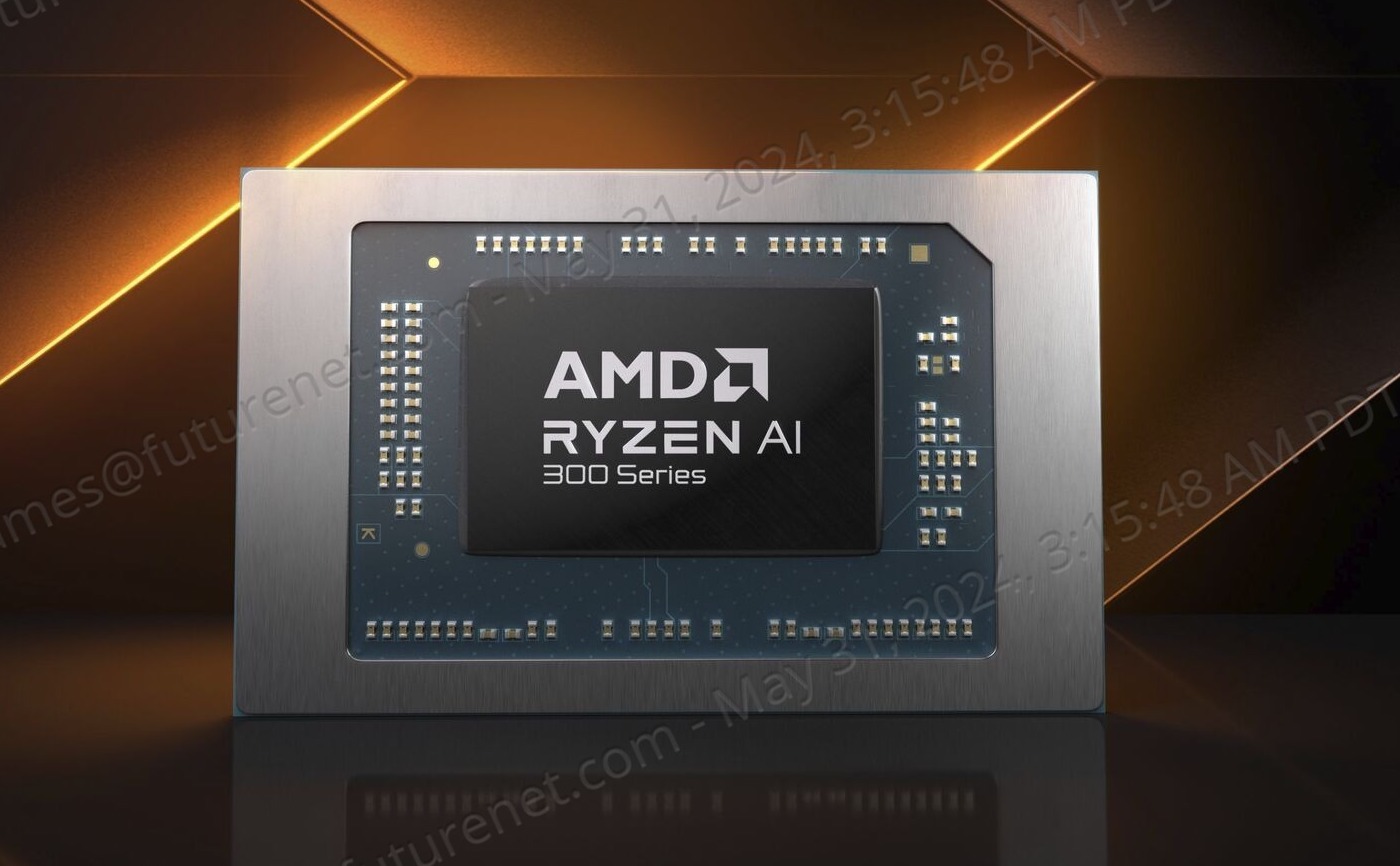
AMD's next-gen Strix Point APU for laptops and, we assume, gaming handhelds has been rumoured for so long it's taken on an almost mythical quality. But thanks to the Computex 2024 tech show, it's here at last and looks like an absolute beast, with more CPU cores, more GPU compute units, a much more powerful NPU, the whole works.
The first laptops with the new APU go on sale in July and guess what? Yup, the rumoured "Ryzen AI" branding is true. The new chip will be known as the Ryzen AI 300 Series. Indeed, the rumour that AMD changed the branding from Ryzen AI 100 to Ryzen AI 300 at the last minute is also true. Some elements of the marketing materials hadn't been fully updated and "Ryzen AI 100 Series" remains stencilled onto at least one of the images of the chip. Whoops.
But enough pre-launch trivia, what makes Strix Pont tick? First up, it combines both Zen 5 and Zen 5C cores. You can read more about AMD's new CPU design in Nick's article about the new Ryzen 9000 desktop chips, which AMD is also launching today. But AMD is claiming 16% average IPC gains, which is a decent generational uptick.
Clock speeds are comparable to previous APUs but what isn't is the core counts. Where the old 7000-series Phoenix and 8000-series Hawk Point APUs—as seen in various laptops and gaming handhelds—had up to eight CPU cores, Strix Point packs four Zen 5 cores and up to eight Zen 5C cores.
Zen 5C, in case you were wondering, is AMD's compact CPU core but has exactly the same execution units as Zen 5, just less cache. The consequence is that a block of Zen 5C cores taken up significantly less space than the equivalent number of fully cached Zen 5 cores. For some software, like media encoding, Zen 5C will be pretty much as fast as Zen 5. For gaming, the extra cache in Zen 5 makes a noticeable difference.
| Header Cell - Column 0 | AMD Ryzen AI 9 HX 370 | AMD Ryzen AI 9 365 |
|---|---|---|
| Cores | 4 Zen 5, 8 Zen 5C | 4 Zen 5, 6 Zen 5C |
| Maximum boost clock | 5.1GHz | 5GHz |
| Total L2+L3 cache | 36MB | 34MB |
| GPU | Radeon 890M | Radeon 880M |
| GPU spec | 16 RDNA 3.5 CUs | 12 RDNA 3.5 CUs |
| NPU | 50 TOPS | 50 TOPS |
That, of course, will mean some careful thread scheduling will be required to ensure that critical game threads are prioritised for those Zen 5 cores. But this is nothing new. AMD already does this for its asymmetric multi-chip desktop CPUs with 3D V-cache on one CPU die and not on the other, such as the Ryzen 9 7950X3D.
Anyway, at launch there are two models. The AMD Ryzen AI 9 HX 370 with four Zen 5 cores and eight Zen 5C cores for a total of 24 threads, with 36MB total cache, and a 5.1GHz maximum boost clock.
The biggest gaming news, reviews and hardware deals
Keep up to date with the most important stories and the best deals, as picked by the PC Gamer team.
Meanwhile, the AMD Ryzen AI 9 365 loses two Zen 5C cores, drops to 34MB of cache and runs a tiny bit slower at 5GHz. And yes, that's correct, one is a Ryzen AI 9 "HX" chip, the other is simply Ryzen AI 9. Tech branding, go figure.
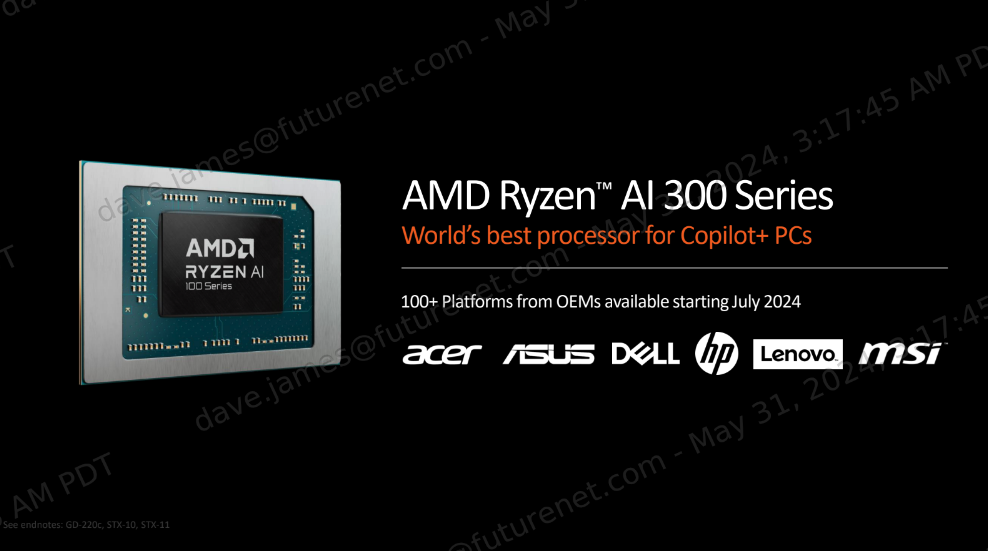
The other major element, of course, is graphics. Strix Point ups the graphics CU (or compute unit) count from the 12 CUs of its previous best APU to 16 CUs for the top Ryzen AI 9 HX chip. The non-HX model sticks with the same 12 CUs as the Ryzen 7 7840U and 8840U.
But hang on, those CUs aren't the same RDNA 3 tech as before. AMD is calling it RDNA 3.5. Unfortunately, AMD isn't being terribly forthcoming about the details, but the rumours thus far suggest RDNA 3.5 is mostly carried over save for a fairly major improvement in ray-tracing performance. Hopefully that's true, because the only thing really wrong with RDNA 3 is its comparatively weak ray tracing performance.
The other major element is the AI-accelerating neural processing unit (NPU) and here AMD has made the biggest gains. AMD is claiming 5x gains in performance and twice the efficiency of the first NPU in the Phoenix APU.
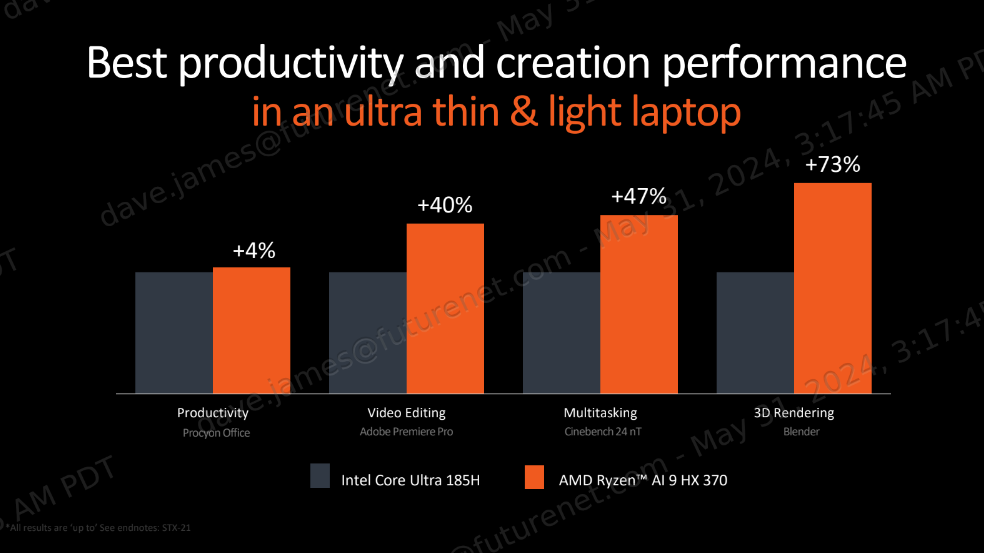
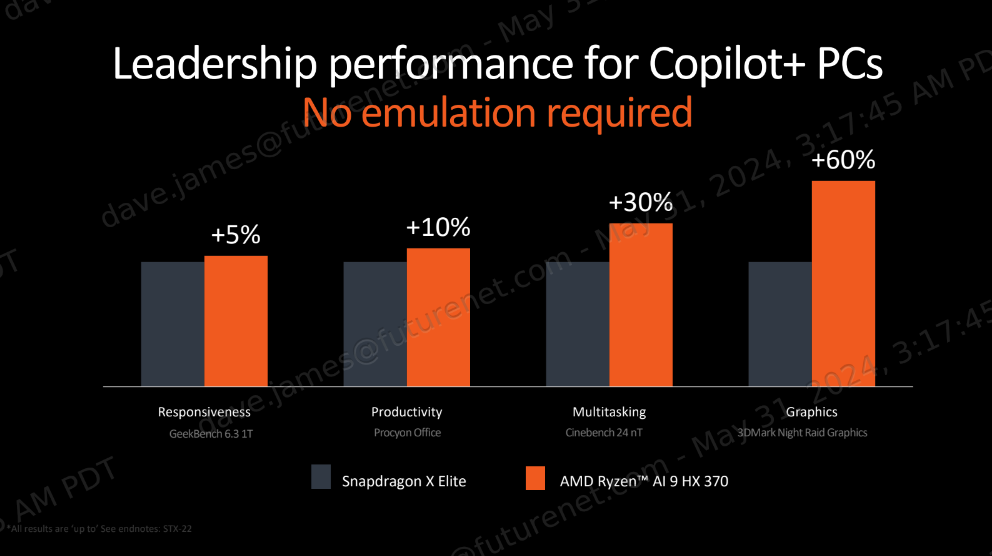
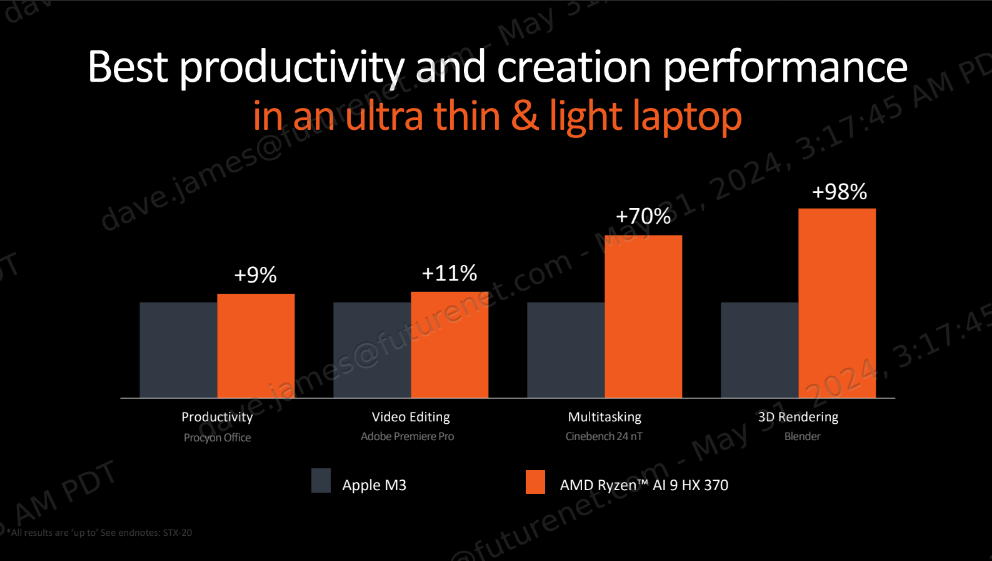
All told, AMD says the new NPU in Strix Point is good for 50 TOPS of AI performance. Notably, that's more than the 45 TOPS of the new Qualcomm Snapdragon X Elite chips that will be first to market with Copilot+ chops, if only by a few weeks.
Microsoft, of course, has set a minimum 40 TOPS to qualify for its official Copilot+ AI PC standard. So the Ryzen AI 300 Series will be the first bona fide x86 chip to meet that standard.
Notably, AMD stated that it delivers all of its performance capabilities with "no emulation required", a clear dig at the Snapdragon chip and its Arm CPU cores, which will need to emulate any legacy x86 apps that aren't available in native Arm format.
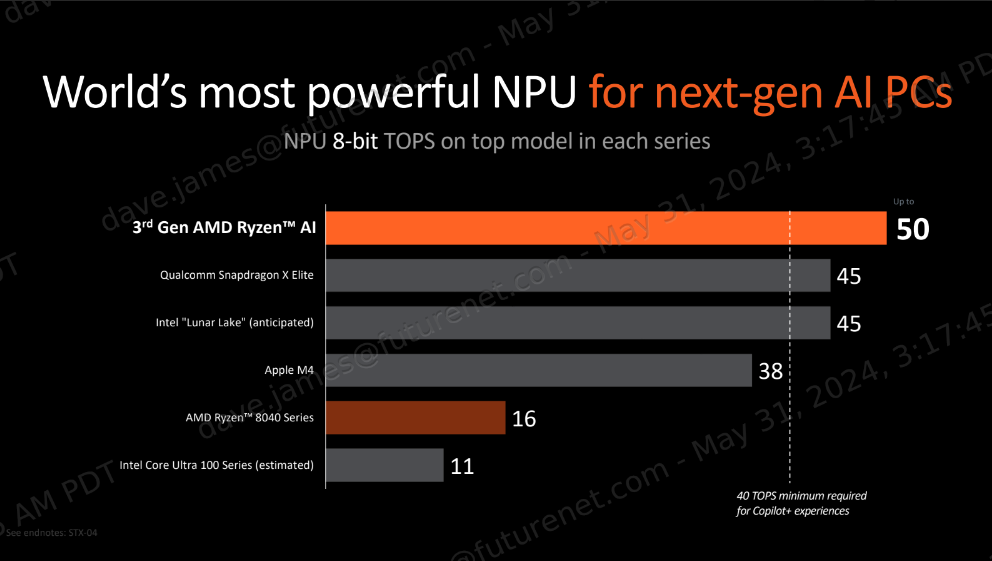
Speaking of performance, how does this new APU stack up? So far, we only have a few AMD metrics to go on. For the most part, AMD isn't comparing the new chip to its previous APUs, preferring to stack it up against the likes of Intel's Meteor Lake alternative.
Comparing it to the Intel Core Ultra 9 185H, AMD reckons the Ryzen AI 9 HX 370 is 47% faster than the Intel chip in Cinebench rendering and 40% faster in video encoding. For gaming on the integrated GPU, AMD is claiming the gap is anywhere between 28% and 47%, though it's not clear what settings are being used or at what power level.
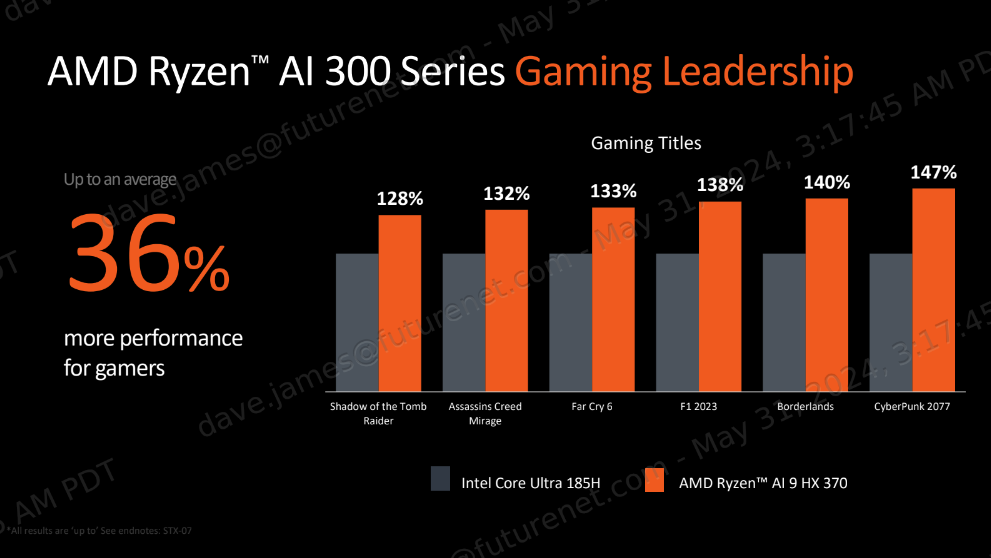
Another detail AMD is talking about for now is the silicon node being used for these new APUs. We're almost certain it will be TSMC 5nm, also known as 5N, or something very close to that, rather than one of the very latest N3 nodes. Were it the latter, you can be sure AMD would be shouting about it.

Best CPU for gaming: The top chips from Intel and AMD.
Best gaming motherboard: The right boards.
Best graphics card: Your perfect pixel-pusher awaits.
Best SSD for gaming: Get into the game ahead of the rest.
Still, this is a very strong showing overall. If anything, we're most excited about it as the basis of a handheld gaming chip. An extra four graphics CUs, plus that anticipated ray-tracing upgrade bode awfully well, though it's not clear what the battery life implications may be.
On that note, it's conspicuous that AMD hasn't said much about battery life. If it is using the same or similar silicon node technology, any efficiency gains would be architectural from the Zen 5 cores. We'll see, but as ever if AMD isn't making a lot of noise about battery life gains, it makes sense to keep expectations in check.
Anyway, AMD's laptop APUs were already very competitive. These new ones look likely to increase its advantage. We can't wait to get hold of a laptop—or even better, a handheld—with Strix Point onboard.

Jeremy has been writing about technology and PCs since the 90nm Netburst era (Google it!) and enjoys nothing more than a serious dissertation on the finer points of monitor input lag and overshoot followed by a forensic examination of advanced lithography. Or maybe he just likes machines that go “ping!” He also has a thing for tennis and cars.

